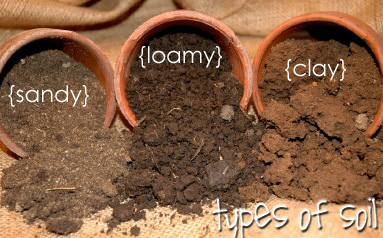How many Different Types of Soil are there
Types of soil
The difference in particle size of the various soil constituents gives rise to a property called texture. The easiest way to identify the type of soil is to take some, wet it, and roll it between your fingers.
- If it is very gritty and pale brown, then it is sandy.
- If it makes a shiny smooth coating on your fingers and is greyish-brown, then it is clayey.
- If it is flaky and dark, then it is loamy.

Based on the proportion of sand, silt, clay, and humus present, soil can be sandy, clayey, or loamy. The differences between them are given in Table.
| Sandy soil | Clayey soil | Loamy soil |
| More than two-thirds of sandy soil is sand, and about one- tenth is clay. | More than two-thirds of clayey soil is clay. | Loamy soil has sand and silt in equal amounts, about two-fifths each. One-fifth of loamy soil is clay. |
| It is made up of large particles with large air spaces. | It is made up of fine particles with small air spaces. | It has high humus content. |
| Its porosity prevents retention of water. So it dries up very easily. | It retains moisture and becomes very sticky when wet. When dry, it becomes hard and forms deep cracks. To improve this soil, chalk can be added. | It is porous and also holds moisture. |
| It is well suited for fruit and vegetable cultivation. | It is good for making pots. | It is good for cultivation of crops and gardening. |
Soil suitability for crops
Soil does not have the same properties everywhere, and therefore different varieties of plants can grow in different areas. That is why we have some places growing more of a particular crop than others. Wheat primarily comes from Punjab, Uttar Pradesh, and Haryana. The major rice-producing states are Punjab, Andhra Pradesh, and Uttar Pradesh. A soil suitable for growing crops has to be fertile. Soil fertility refers to the capacity of the soil to provide nutrients in adequate amounts and in proper balance for the growth of plants. For a soil to be fertile, other growth factors such as light, moisture, and temperature should be favourable.
To make a soil more fertile, some adjustments are done to its property. These adjustments are
- Alteration of pH
- Alteration of air content (aeration)
- Addition of fertilizers
Acidity or alkalinity (pH) affects the ability of plant roots to take up minerals from the soil. A fertile soil should have somewhat neutral pH. Lime (calcium carbonate) is added to acidic soils to raise the pH (make soil more alkaline). Peat is added to alkaline soil to lower the pH (make soil more acidic). Soil with a low air content has high water content, and so is heavy and difficult to work with. It can be improved by drainage of water from the soil by ploughing. Fertilizers are added to soil which have low mineral content such as nitrate, phosphate, potassium, and magnesium.
